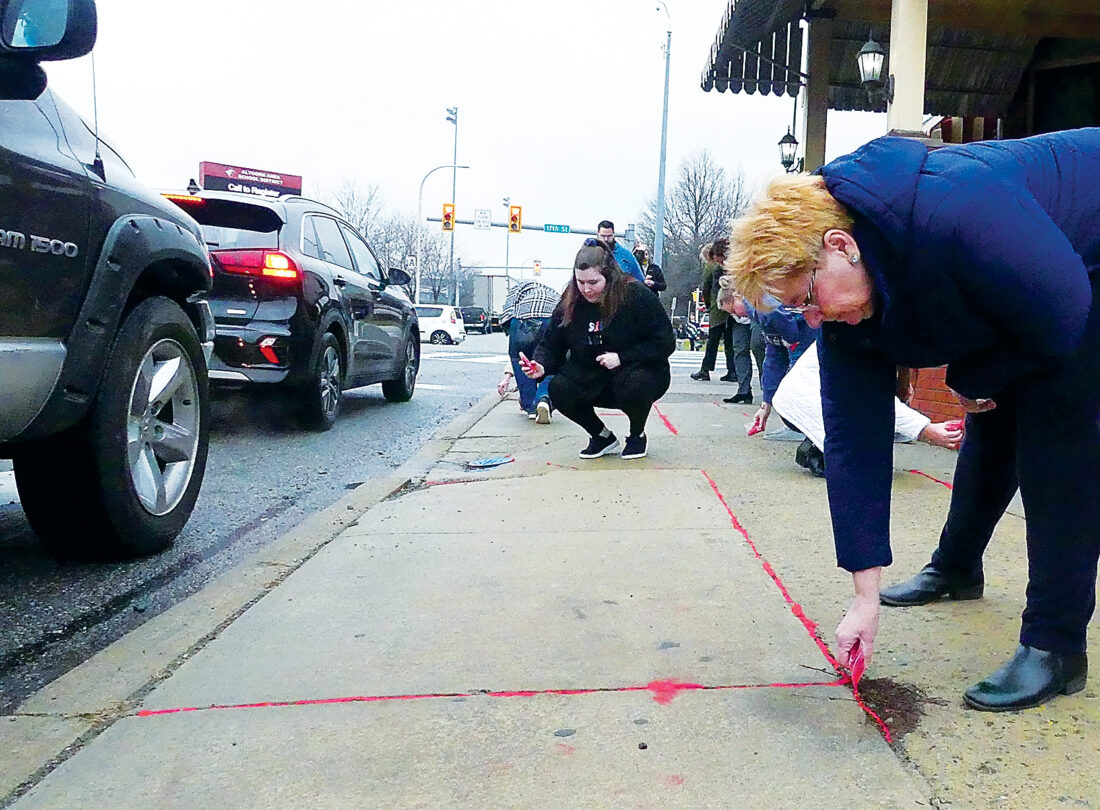
Lisa Hann, executive director of Family Services Inc., pours red sand in the cracks of the sidewalk in front of the teen shelter at Sixth Avenue and 17th Street to symbolize the victims of human trafficking who have “fallen through the cracks of society.”
Mirror photo by William Kibler
<!–
Movies like “Taken” dramatize human trafficking with kidnappings, shadowy villains and international intrigue.
Human trafficking occurs in those contexts, but also in far more ordinary circumstances — including here in Blair County, say local victim advocates.
Several advocates were outside the Agarwal Teen Shelter on Tuesday spreading red sand between the sidewalk slabs to symbolize the victims of trafficking who’ve “fallen through the cracks” of society — as part of the international Red Sand Project, in observance of Human Trafficking Awareness Month.
The Victim Services Program employees of Family Services Inc. are trying to dissolve the “myth” that trafficking occurs only in settings like those depicted in cinematic portrayals of society’s underbelly, according to Ashley Gay Vocco, the program director.
They’ve been talking to shelter residents about “what trafficking (really) looks like” locally, she said. “To take away (that) myth.”
Here, many who are being exploited are unaware that they’re victims, according to the advocates.
They include girls with love interests who are merely “playing the boyfriend,” she said.
In such cases, males trade on their seemingly generous behavior — buying the girls a “pretty ring” or taking them out to dinner — and on problems they claim to be facing, like being short on rent, to press the girls to sleep with “a friend,” for example, Gay Vocco said.
The girls see it as a favor, and don’t know about the payment the “boyfriend” receives.
Far from being taken away to disappear in a foreign underworld, such victims may go home to dinner with their family that evening, said Gay Vocco and Lori Craine, director of clinical services for Blair Health Choices, which manages behavioral health care for Medicaid recipients locally.
Traffickers include other kinds of people the victims know — including fathers, who may be pimping for “Dad’s best friend,” according to Gay Vocco.
Bachelor parties are sometimes the settings for trafficking, she said.
Traffickers generally exploit vulnerabilities, according to Gay Vocco and Richard Servello, program coordinator for Victim Services.
“We all have them,” Gay Vocco said, noting vulnerabilities include hunger, loneliness, mental health problems and homelessness.
Some victims trade sex for food.
LGBTQ youth are especially susceptible, particularly if they’ve been rejected by their families, which sometimes results in them leaving home, Servello said.
Kids need safety and security, and when they don’t have it, they’re easily preyed upon, he said.
Any kind of unstable family life creates risk, with potential victims inclined to go elsewhere for love, affection and acceptance, Gay Vocco said.
Addiction is a major vulnerability.
“Drugs and trafficking go hand in hand,” she said.
The need of an addict for drugs provides an easy tool for manipulation by a trafficker, Craine said.
It’s extortion, she said.
It’s “sextortion,” Gay Vocco said.
What about the cases in which there are elements of voluntary prostitution, with the victim receiving some form of payment?
“No young girl wakes up one day” and says to herself they want to become a prostitute, Gay Vocco said.
If nothing else, sex in such cases is likely to generate shame, while also blurring the boundary with healthy relationships, according to Servello and Craine.
Authorities in Blair have been slower to identify trafficking here than authorities in big cities, Gay Vocco said.
But there have been recent court cases that involve trafficking, including some in which trafficking per se isn’t among the ultimate charges, she said.
When minors are the victims, prosecutors need to show only that the transaction wasn’t made with “eyes wide open,” Gay Vocco said.
When adults are the victims, prosecutors need to show that coercion, fraud or the threat of force was used, she added.
Many cases that have come to the attention of the Victim Services Program were handled by Family Services’ Children’s Advocacy Center, which provides forensic interviews and medical evaluations and mental health referrals that are meant to reduce trauma when the authorities suspect abuse, Gay Vocco said.
There has been evidence that trafficking sometimes occurs here matching the more sophisticated kind presented in movies, she added.
That evidence has surfaced in statements from survivors who’ve been brought here from other locations in connection with major sporting events, such as Penn State football games, then taken back to where they came from, she said.
Red Sand Project actions to raise awareness of human trafficking have taken place in all 50 states and in 70 countries, according to the project’s website.
The sand used outside the Teen Center is natural, despite its bright red hue, and thus not an environmental hazard.
Red was chosen because “it pops,” Gay Vocco said.
Mirror Staff Writer William Kibler is at 814-949-7038.








